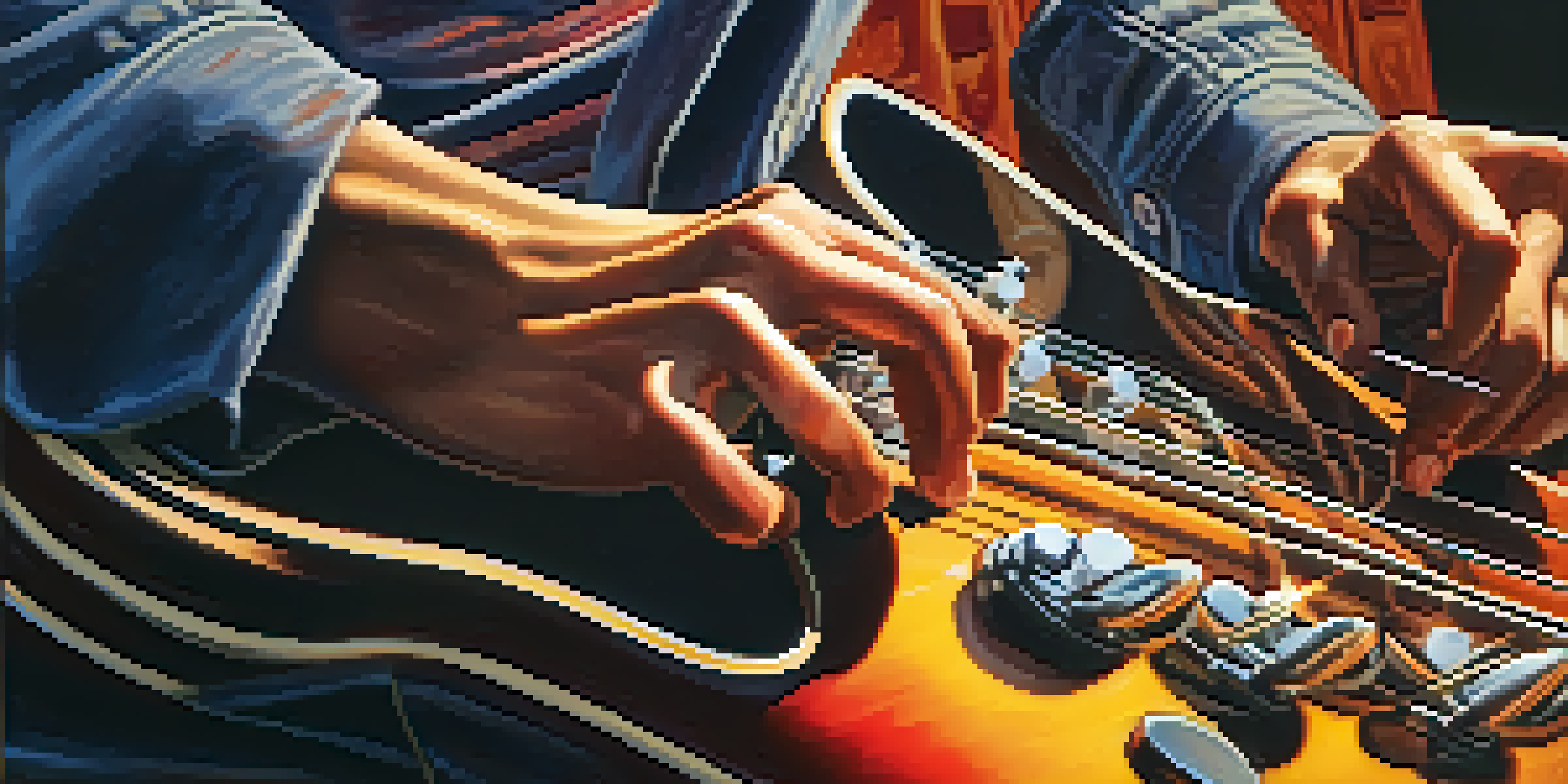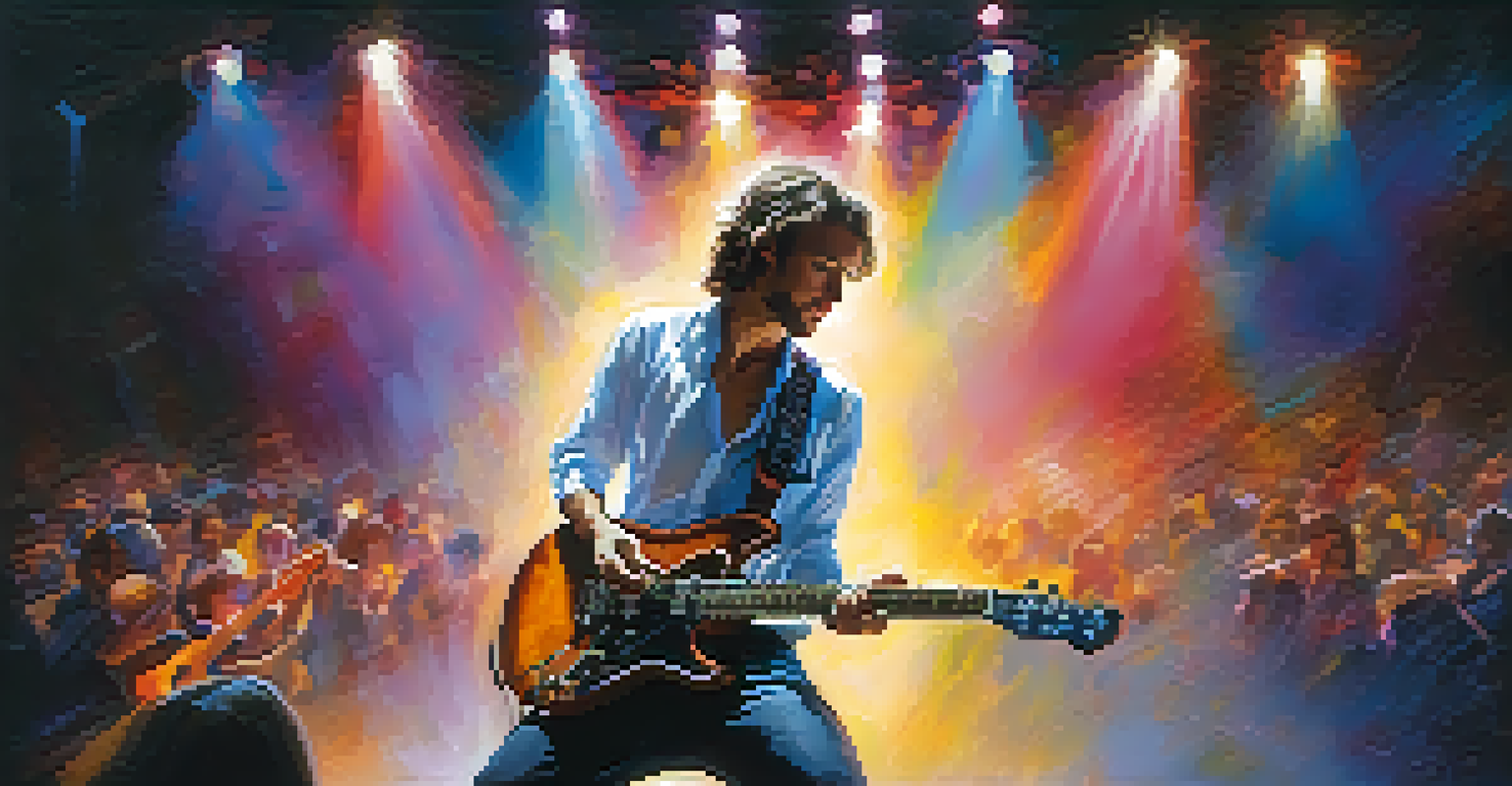Tapping Techniques: Unlocking New Dimensions on the Guitar

Introduction to Tapping: What Is It and Why Use It?
Tapping is a guitar technique that involves using your fingers to 'tap' notes on the fretboard, rather than strumming or picking. This method opens up a whole new dimension of sound, allowing you to play faster and create smoother melodies. It’s especially popular in rock and metal genres, but it can add flavor to any style.
Music is the shorthand of emotion.
Imagine a keyboard player, effortlessly hitting keys with both hands. Tapping on the guitar brings a similar dynamic to the table, enabling players to produce intricate and rapid note sequences. This technique can make a single guitar sound like multiple instruments, captivating your audience with its versatility.
Related Resource
For those looking to stand out, mastering tapping techniques can be a game changer. Not only does it enhance your skill set, but it also provides a unique sonic signature that distinguishes your playing from others. So, let’s dive into the world of tapping and explore how to unlock its full potential.
The Basic Technique: Getting Started with Tapping
To begin tapping, you'll want to use your dominant hand to tap the fretboard while your other hand provides support on the strings. Start with your index or middle finger of your picking hand, and lightly press down on the chosen fret. This initial approach is crucial for creating clean notes without unwanted noise.

As you tap, remember to maintain a relaxed posture. Tension can lead to mistakes and fatigue, so practice with a loose grip. It’s helpful to start with simple melodies or scales to familiarize yourself with the motion and develop muscle memory.
Master Tapping for Unique Sound
Tapping enhances your guitar skills, allowing you to create intricate melodies and stand out in any musical genre.
Don’t forget to incorporate your fretting hand! While tapping, your fretting hand can create harmonies or additional notes, making your playing richer. With practice, you'll find that tapping can become a seamless part of your guitar vocabulary.
Common Tapping Patterns: Building Your Arsenal
Once you're comfortable with the basic technique, it’s time to explore common tapping patterns. A classic example is the 'tapped arpeggio,' where you tap the notes of a chord in a sequence. This creates a flowing sound that can be both melodic and rhythmic, perfect for solos.
The beauty of music is that it transcends language.
Another popular pattern is the 'hammer-on and pull-off' combination. By using your fretting hand to perform these techniques alongside your tapping, you can create a series of rapid notes that maintain a smooth transition. This builds complexity in your playing while keeping things engaging.
Related Resource
Experimenting with different patterns is key to developing your unique style. Try mixing tapping with slides or bends to see how they interact. The goal is to find combinations that resonate with you and enhance your musical expression.
Famous Songs Featuring Tapping Techniques
Many iconic songs showcase tapping techniques, making them great examples for learning. Think of Van Halen's 'Eruption,' which features some of the most famous tapping sequences in rock music. This track is not just a showcase of skill but a testament to how tapping can create an unforgettable sound.
Another excellent example is 'Sweet Child O' Mine' by Guns N' Roses, where tapping adds a beautiful melodic layer to the guitar solo. These songs illustrate how tapping can elevate a piece, transforming it into something memorable and emotionally resonant.
Common Patterns Build Skills
Exploring common tapping patterns, like tapped arpeggios and hammer-ons, can significantly improve your playing technique.
Listening to and practicing these songs can provide inspiration and insight into how tapping works within a musical context. It’s a fantastic way to see the technique in action and understand its potential in various genres.
Tapping and Improvisation: Finding Your Voice
Tapping is not just about playing existing songs; it’s also a powerful tool for improvisation. When you incorporate tapping into your solos, you can explore new melodic ideas and create unexpected musical moments. This spontaneity can lead to unique performances that captivate your audience.
To improvise effectively with tapping, start by familiarizing yourself with the scale or key you're working in. As you gain confidence with tapping, you'll find it easier to express yourself musically. Try letting your instincts guide you as you tap out melodies that resonate with your emotions.
Related Resource
Remember, improvisation is about experimentation. Don’t be afraid to make mistakes; they can often lead to new discoveries. The more you practice improvising with tapping, the more you'll develop your own musical voice.
Advanced Tapping Techniques: Taking It to the Next Level
Once you feel comfortable with basic tapping, you may want to explore advanced techniques. This could include two-handed tapping, where both hands are used to create complex patterns and harmonies. This technique opens up a world of possibilities for intricate melodies and fast passages.
You can also experiment with tapping in different styles, such as jazz or fusion, where the technique can add unexpected flavors and textures. Incorporating techniques like legato or harmonics can further enhance your sound and allow for greater expressive capabilities.
Practice Improvisation with Tapping
Incorporating tapping into improvisation helps you discover new melodic ideas and develop your unique musical voice.
As you delve into advanced tapping, remember to keep your practice focused and deliberate. Set specific goals for each session, whether it’s mastering a new technique or improving speed. With dedication, you'll see progress and expand your tapping repertoire.
Tips for Practicing Tapping Techniques Effectively
Effective practice is essential for mastering tapping techniques. Start by breaking down complex patterns into smaller, manageable sections. This makes it easier to focus on each part before combining them into a complete phrase. Slow practice is key—speed will come with time.
Incorporating a metronome can help you maintain a steady rhythm as you practice. Gradually increase the tempo as you become more comfortable with the techniques. This will build your confidence and ensure you can play the patterns accurately at higher speeds.

Additionally, record yourself while practicing. Listening back allows you to identify areas for improvement and track your progress. With patience and persistence, you'll find that your tapping skills will flourish.